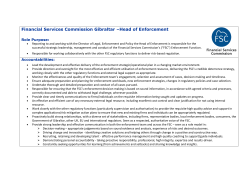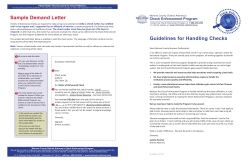
PB 5 Case Study Policy Brief - EUTR CITES AML - CH
EUROPEAN POLICYBRIEF ENVIRONMENTAL CRIME: EUTR, CITES AND MONEY LAUNDERING CASE STUDY Policy Implications for the EU Policy Brief 5: March 2015 OVERVIEW OF CASE STUDY Illegal logging, and the trade in illegally harvested wood, is a major factor in deforestation, climate change and the global loss of ecosystems. At the same time, it fuels corruption and conflict in some of the world’s most fragile countries, while undermining sustainable and equitable development. Illegal logging began to attract political attention in the late 1990s, and became the central theme of a number of regional Forest Law Enforcement and Governance (FLEG) conferences coordinated by the World Bank as well as a component of the G8 Action Plan on Forests. By the early 2000s, however, it was becoming clear that focusing solely on the ‘supply’ side of the problem was unlikely to result in significant progress, since the incentives of exporting illegally logged wood remained greater than the likely penalties. The EU response to this issue was framed through its FLEGT Action Plan, agreed in 2003. As a result of this, the EU Timber Regulation was developed, which prohibits placing illegal timber on the EU market and establishes a requirement for industry to implement due diligence to avoid the risk of doing so. Also within the framework of the Action Plan, Voluntary Partnership Agreements (VPAs) were negotiated with producer countries, under which only legally licensed timber can be imported to the EU. This case study focuses on implementation of the EU Timber Regulation, and its interaction with two other policy regimes: the Convention on International Trade in Endangered Species of Wild Fauna and Flora (CITES) and anti-money laundering legislation (AML). Looking at four EU countries (the Czech Republic, Italy, the Netherlands and the United Kingdom) and two producer countries (Ghana and Indonesia) it describes the relevant sanctions regimes and enforcement efforts, considers their effectiveness and identifies opportunities for improved cooperation by national and EU agencies. The EUTR came into force in March 2013. It has an explicit link with CITES, since timber with a CITES permit is considered to have been legally harvested under the regulation. Concerns have been raised that this could create a loophole for the entry of illegal timber into the EU, due to weak implementation of CITES in some producer countries. However, it also presents an opportunity to drive up standards in CITES. With regard to enforcement, the paper finds that, given the early stage of implementation of the EUTR, enforcement has been good in many countries. Furthermore, cooperation between enforcement agencies for EUTR and CITES has been working well. However, the paper also identifies a significant variance in the level and quality of enforcement between member states, a situation that has been exacerbated by the European Commission’s slow response in providing - EUROPEANPOLICYBRIEF - Page|1 support and guidance for implementation. In the producer countries there appears to be relatively good coordination between VPA and CITES institutions, suggesting that, as timber legality licensing systems become established, the credibility of CITES export permitting should also improve, at least within VPA countries. In neither producer nor consumer countries has anti-money laundering legislation generally been relied on to address illegal logging. In considering the parameters that guide criminalization of environmentally harmful behaviour, the paper concludes that in practice it is the type of sanctions available, rather than consideration of what types of activities ought to be criminal, that determine whether or not countries choose to employ criminal or administrative law. The case study is based on qualitative analysis of interview data gathered from enforcement officials and experts on the EUTR, VPAs and CITES institutions in four European and two producer countries. POLICY IMPLICATIONS AND RECOMMENDATIONS FOR THE EU While enforcement of the EUTR and CITES is a member state prerogative, EC leadership is essential to establish consistency across the EU, mediate between different legislative and administrative approaches and avoid the appearance of ‘weak links’ in the single market. The Commission has recently signalled its willingness to increase political pressure on member states that are not yet actively enforcing the EUTR; effective enforcement by all member states will be essential to ensure the regulation will serve its objectives. Establishing norms and timelines for implementation and enforcement, and identifying the member states that fail to meet them, through benchmarking, best practice transparency measures and peer accountability mechanisms, can help to improve the consistency of implementation of environmental legislation across the EU. Experience of working with enforcement officials for EUTR and CITES has shown that important lessons can be learned from other regulated sectors. Ensuring that experiences are shared from other areas of legislation, whether categorised as environmental or not, could have significant benefits for in terms of both effectiveness and cost. The EUTR’s due diligence requirement creates a ‘dynamic’ norm, whereby the level of understanding and responsibility required of private companies should increase, for example, with improved availability of information, and of new technologies that reduce the costs of high-tech supply chain controls. The European Commission should actively pursue such incremental increases in the level of due diligence required once basic implementation is in place in all member states. The sharing of information between enforcement officials is key to capacity-building, cost-effective enforcement and the consistent application of legislation across the EU. The EU-TWIX database currently facilitates the sharing of information between CITES enforcement officials in real time across the EU. The EC is considering providing resources to establish a similar system for the EUTR. If well designed and sufficiently resourced, such a system would make a significant contribution towards effective enforcement of the EUTR. ABOUT EFFACE CASE STUDIES ON ENVIRONMENTAL CRIME Author of this brief: Jens Hein, Chatham House Full citation of the case study: Saunders, J. and Hein, J. (2015). EUTR, CITES and Money Laundering case study: Challenges to coordinated enforcement in the global forest products sector. A study compiled as part of the EFFACE project. London: Chatham House, available at http://www.efface.eu “European Union Action to Fight Environmental Crime" (EFFACE) is a 40-months research project involving eleven European research institutions and think tanks. EFFACE assesses the impacts of environmental crime as well as effective and feasible policy options for combating it from an interdisciplinary perspective, with a focus on the EU. Project results include several case studies on the causes, actors and victims of different types of environmental crime as well as policy options and recommendations. For more information on EFFACE, see http://www.efface.eu or contact: envcrime@ecologic.eu EFFACE receives funding under the European Union's Seventh Framework Programme for research, technological development and demonstration (FP7) under grant agreement no 320276. The contents of this policy brief are the sole responsibility of EFFACE and can in no way be taken to reflect the views of the European Union. - EUROPEANPOLICYBRIEF - Page|2
© Copyright 2025









